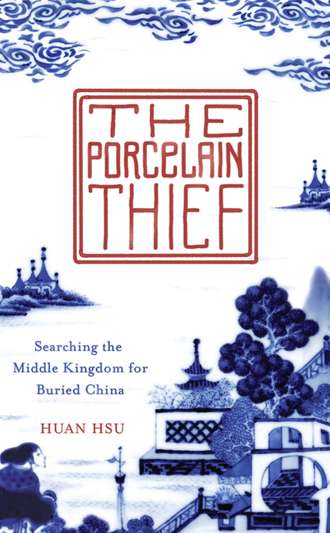
Полная версия
The Porcelain Thief
Only the stone structures of Castiglione’s Western-style villas survived. This complex of palaces had been five times the size of the Forbidden City and is regarded as one of the most magnificent lost treasures in history. A full accounting of the destroyed and stolen artifacts was never completed, as many of the records burned with the buildings; but many of the imperial objects—especially porcelains, which the foreign armies targeted—in Western museums and collections and circulating on the auction market today originated from those sackings, a cultural disaster that still resonates with the Chinese.
As the Qing tried to restore its empire, complicated by other rebellions, plagues, and disease, some progressive statesmen sought to modernize China. These “self-strengtheners” advanced frameworks for the country to adopt Western weaponry and military technology, incorporate modern science, and develop diplomatic strategies. The vision for a reformed China—boasting a healthy mix of traditional Chinese elements with Western ideas and technology—was there. Now it just needed the support of a strong central government to make it a reality.
But inside the Forbidden City, palace intrigues continued. This time it was a concubine—with whom all Chinese rulers consorted except for one, the Ming emperor Hongzhi—at the center, an exceptionally ambitious one who managed to attain real power. Cixi was the mother of all dragon ladies, born to an official family in Anhui, and who journeyed to Beijing as a teenager where she was selected as a concubine for Qianlong’s great-grandson, Xianfeng. Concubines were segmented into ranks, which determined the allotments of food, clothing, jewelry, cash stipends, and handmaidens they received. Cixi entered the palace as a low-rank concubine but ascended quickly after giving birth to Xianfeng’s only son, and when the child reached his first birthday, she was elevated to the second rank, with only the empress above her.
Xianfeng died shortly after the Second Opium War. Eight ministers were appointed to advise his heir, five-year-old Tongzhi, and Cixi was elevated to empress dowager with the expectation that she and the empress would cooperatively help the young emperor as he matured. But Cixi had by then gained a firm grasp of court machinations and quickly maneuvered to consolidate power. Following the coup, and after executing “only” three of the appointed ministers, Cixi issued an imperial edict affirming her as the sole decision maker.
Tongzhi remained the nominal emperor, but Cixi ruled from “behind the curtain,” as she would for most of the second half of the nineteenth century. Tongzhi was an unhappy, stifled young man who died at age nineteen, officially of smallpox, possibly of syphilis. His consort died a few months later, either by committing suicide or because Cixi had starved her to death. She was rumored to have been pregnant with Tongzhi’s son at the time. With no heir apparent, Cixi installed her nephew, Guangxu, as the new emperor.
For many Chinese, Cixi’s legacy, beyond her overprotectiveness, vindictiveness, xenophobia, and paranoia, was excess. Instead of imposing austerity while the government battled the Taiping and other existential crises, she oversaw the production of vast amounts of brightly colored porcelain from the imperial kilns for personal use. To commemorate each of her fiftieth, sixtieth, and seventieth birthdays, she commissioned dinnerware sets and matching boxes. Unsatisfied with her tomb, she ordered it reconstructed from scratch during the First Sino-Japanese War. She was said to have diverted funds designated for modernizing China’s outdated navy—which had been embarrassed again and again in engagements with foreign forces—to pay for the renovation and expansion of the Summer Palace, which became her personal retreat.
FAR REMOVED FROM BEIJING, Liu built the finest residence in Xingang, a sprawling complex of stone buildings arranged around a courtyard and encircled by a brick wall. The estate fronted the dirt road to Jiujiang and featured three pine trees, traditional symbols of longevity, friendship, and steadfastness, under which Liu often set out a bucket of cool water and jars of herbal medicine for travelers resting in the shade during the sweltering summers.
He married the daughter of a rich peasant family that had made its money selling Yangtze River fish. The Yangtze was full of fish back then, shad and herring and Chinese sturgeon, an ancient species that grew to more than ten feet long and a thousand pounds and is now nearly extinct. Each spring fish migrated up the river past Jiangxi to lay their eggs. The fertilized eggs hatched as they floated back down the river. By the time the fry reached Jiujiang, they were transparent needles, and the patriarch of the Yao clan went out around the fifth day of the fifth lunar month and collected these fry, which he sold to buyers from all over the country. His business grew until it became an area industry, but the man remained so thrifty that he would eat three bites of rice for every piece of salted black bean.
Конец ознакомительного фрагмента.
Текст предоставлен ООО «ЛитРес».
Прочитайте эту книгу целиком, купив полную легальную версию на ЛитРес.
Безопасно оплатить книгу можно банковской картой Visa, MasterCard, Maestro, со счета мобильного телефона, с платежного терминала, в салоне МТС или Связной, через PayPal, WebMoney, Яндекс.Деньги, QIWI Кошелек, бонусными картами или другим удобным Вам способом.




